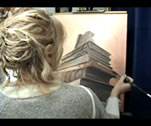This section provides a list of techniques, materials, and common references that are frequently used in the design and decorative painting profession.
A thick body of water borne odorless paint commercially sold in art stores in tubes or in jars. It serves small artistic projects such as canvas and furniture paintings. It can be diluted with a water-based thinner to make it easier to handle, and it is very resilient.
For some projects the use of a brush is quasi impossible, such as, for painting an ornate or twisted piece, wicker furniture or a surface that cannot show the slightest brush mark. It is also the fastest way to paint. You may order in a paint store a custom made color, oil or water-borne, if you have not found the shade readily available on the shelf. You will need to apply several coats, since the film left by the spray is very thin. Most importantly, you need to know that everything surrounding your project must be covered with a drop cloth, because sprayed paint travels very far! The alternative solution is to buy a spraying container on which you can attach a can of compressed air. It will make less mess around you and you can mix and adjust your own color for indefinite use. The drawback remains the frequent cleaning of the aerosol head that clogs up all the more quickly depending on the thickness of your paint solution.
An oil-borne commercial paint, to be thinned or cleaned with paint thinner or turpentine. It is employed less and less frequently, with a view to protect the environment. However, on some projects, such as exterior painting of trims and floors, it is more resilient than latex paint. It carries a strong odor.
In order to age a wall, furniture or an object, many techniques and tools are possible.
The idea is to apply one or several coats of stain or paint; you will need to sand or remove them partly with various tools, paint them again then repeat the distressing process. Now, to do it with serendipity, you have to apply the right shade of stain or paint, remove it just enough for your purpose, and cover it again with another pleasing color. Several layers may need to be applied until you are satisfied. You need to wait between each coat until the last one is thoroughly dryto avoid reactivating the last layer with the new coat.
whether you design a room, execute a mural or devise a color scheme, you need to envision the global impact of your work and the final arrangement of the wall, the room, or the succession of rooms that are tied together. The eye grasps the whole picture of a decor, its balance, its imperfections, its constraints; it needs to flow, and you have to ensure that your intervention will contribute to emphasize the existing positive features of the site and alleviate or erase its defaults.
Mostly used for artist paintings and to tint fine glazes for faux finishes. For the latter use, you do not need to buy the most expensive brand, however, to paint on canvas, you want to use a top quality oil containing more pigment (or chroma), finely ground, with a good light fastness to avoid color fading with exposure to light, and less yellowing oil or thick medium.






